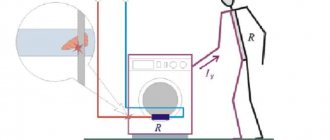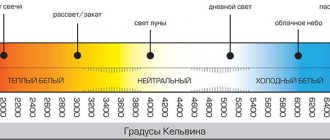- quick identification of wire purpose (phase, neutral or ground)
- reducing the number of erroneous connections during the installation process
- no need to test the wire for phasing
Manufacturers choose conductor colors not according to their own wishes, but according to the rules. Moreover, not only a color, but also a numerical and alphabetic designation can be applied to the conductor.
The color is applied along the entire length of the core insulation. But in some areas you can also use multi-colored cambrics for heat shrink. They are mainly widely used in cable terminations.
Coloring for 220V and 380V single-phase and three-phase voltage
In a three-phase network, wires and buses were previously colored as follows:
Phase A
Yellow color
Phase B
Green color
Phase C
Of red color
To make it easier to remember the order of colors, electricians used the abbreviation ZH-Z-K.
From 01/01/2011, new standards were introduced in accordance with GOST R 50462-2009 ():
Phase A
Brown
Phase B
Black
Phase C
Grey
Now it's time to switch to abbreviations - K-H-S! Subjectively speaking, this marking is inferior in clarity to the previous color scheme Zh-Z-K.
Imagine that there is poor lighting in the control room or room, dust on the wires? Which do you think your eye is better at distinguishing between yellow and green or brown and black? The rules in this case stipulate the need for letter designation and marking of the cores, in addition to color.
Blog
With the help of this material, I want to help newcomers and old-timers understand and understand the features of color marking of wires and cables in accordance with the standards of the Republic of Belarus and not only.
Recently I had the opportunity to connect an apartment switchboard, which came with about 30 cables, with different color markings for the cores. The joke was that the markings were so different that each electrician (and there were two teams working at the site) interpreted the color markings in their own way.
Naturally, there were some problems, and in one day (as usual) I was not able to connect the shield, since my opinion on the color of the wires did not coincide with the opinion of other electricians. I had to spend another day to ring all the lines for proper connection in the switchboard.
Letter designation of wires
What should be the letter designation of wires according to GOST is presented in the following tables:
It is best to apply these letters using special tag rings.
They are a PVC tube, pre-cut, with letters and numbers printed on it.
According to the new rules, marking phase conductors yellow or green is prohibited. Precisely because of their similarity with the yellow-green grounding conductor.
It is also worth noting that the brown color is precisely phase A or L1 (simply L in a single-phase 220V network), and black is phase B or L2. When you conduct wiring for yourself, you may unwittingly miss this moment. But if the electrical work is being done for an industrial facility, then you will be required to strictly adhere to the international standard and correct phasing.
White color is the cheapest option when making core insulation, as it does not require the use of dyes. Therefore, it is most often used by manufacturers of cheap cable brands. There are no special labeling guidelines for this color.
Rules for observing phase markings during installation
Depending on the conditions of the upcoming installation, as well as the availability of auxiliary material, professional electricians use the appropriate marking option.
If a cable with a set of wires is being installed for the first time, experts recommend purchasing wires whose insulation has the appropriate color. If wires or cables are already in use (introduced into distribution devices), marking is carried out in one of the following ways:
- to distinguish cores of a single color (in a self-supporting SIP wire, for example), pieces of PVC pipes of various diameters with lettering are used;
- the same option, but implemented by using pieces of heat-shrinkable tubing;
- hanging thick cardboard tags on the conductors indicating the purpose of each specific core.
attention:
In the second and third cases, the inscriptions are sealed (isolated) with transparent tape, ensuring their long-term preservation.
The first and second marking methods guarantee a tight fit of the marks to the protective sheath of the cable, preventing them from breaking when pulled through pipes.
Errors and color options for phase, neutral and ground wires
The issue of marking wires by color becomes acute when the wiring is installed by one electrician and then serviced by another. If you follow all the color rules, you will save a lot of time and money on troubleshooting.
Unfortunately, in old Soviet wiring, most of the conductors are single-colored and there is no way to do this without a probe or multimeter.
If color marking exists and is observed, then the neutral and protective wires should be:
Neutral wire N should be blue. Zero protective PE – yellow-green. The conductor combining the protective zero and the working zero PEN is yellow-green along the entire length of the wire, but at the end at the junction it is blue.
When coloring phase wires, the manufacturer is given a choice from a variety of color options. Here are the main ones:
Non-standard wire color options
Sometimes, due to incorrect labeling of colors by manufacturers, GOST standards have to be ignored. For example, you have 3 wires in a cable of different colors:
- blue
- brown
- black
In this case, you do the phase according to the rules, namely in brown. The neutral wire will be blue. But the black core will become grounding. In this version, the colors will at least resemble the Soviet standard.
Another of the “inconvenient” options for combining colors of cable cores:
- black
- blue
- red
To violate GOST as little as possible and be close to its requirements, make the phase black. Blue is zero, but red will be the protective conductor PE.
Just be sure to mark it at the end with yellow and green electrical tape.
What to do if the cable does not have a single color that resembles a phase wire? That is, the colors black, brown and gray are missing. Then choose for the phase the wire that corresponds as closely as possible to the brown color established by the rules. For example, red.
For two-core cables, in which the colors black and white are often found, also rely on GOST:
- black will be phase – L
- white – zero combined with grounding PEN
If a tap goes from a 3-phase 380V cable to a single-phase 220V network, then the outgoing core must be the same color as the power wire. When you do come across a cable with a missing core color, you can use colored digital cambrics.
At the ends of the wires, according to the phasing, you can put on multi-colored insulating thermal tubes or multi-colored electrical tape.
To avoid resorting to such methods, at the stage of purchasing and selecting a cable, pay attention to its color in advance.
How to protect yourself?
Having learned about the danger posed by the loss of zero, we suggest considering options for protecting against this phenomenon:
- You need to start with proper installation of electrical wiring. If it is planned to use a three-phase power supply circuit to power the facility, then it must be calculated in such a way as to minimize the likelihood of phase imbalance. That is, it is necessary to systematically distribute the load on each line.
- Devices that balance the load on each phase should be used in network management. Moreover, ideally, this work should be carried out without the involvement of operators, that is, it should be performed automatically when the zero is broken.
- It should be possible to quickly change the consumer connection scheme. This allows adjustments to be made if at the design stage the load on each section was not properly taken into account or the power consumption increased due to the commissioning of new facilities. That is, if a critical situation arises, it must be possible to change the power. An example is when an apartment building is transferred to a line with a higher load to “dilute” the phase imbalance that occurs when the zero is broken.
In the above options, we considered protection against distortions on a global scale; the end user can provide the required level of protection much easier. To do this, it is enough to install a voltage control relay, in which you indicate the permissible minimum and maximum levels. As a rule, this is ±10% of normal.
Colors of wires in electrical engineering: designation of phase, zero and ground in 220, 380 V networks
The method is used when searching for places where wiring is broken, if the location of the grounding and neutral conductors at one of the ends is known, for example, in a distribution panel.
Expert opinion
It-Technology, Electrical power and electronics specialist
Ask questions to the “Specialist for modernization of energy generation systems”
How to determine phase, zero and grounding yourself, using improvised means? As a result, if problems occur with the neutral of the transformer zero of the source, there is a high probability of failure of devices connected to the network. Ask, I'm in touch!
Checking the correct connection
Unfortunately, not all electricians strictly follow the standards and make mistakes in choosing a conductor when making connections. Therefore, when hanging a chandelier, installing a socket or other electrical installation device, it is better to additionally check whether the insulation of each core corresponds to its purpose.
For identification, installers use two methods: the first is checking with an indicator screwdriver, the second is using a tester or multimeter. The phase is usually determined with a screwdriver, and neutral and zero are determined with measuring instruments.
How to use the indicator?
Even such simple devices as indicator screwdrivers are different. Some of them are equipped with a small button, others are triggered automatically when a metal rod and a current-carrying conductor or contact are connected.
DC network
A DC network differs from an AC network in that it contains two conductors: plus and minus. The core of the positive conductor is marked in red, and the core of the negative conductor is marked in blue.
The practice of color separation of wires is familiar to professionals and amateurs; it is actively used in electrical engineering, but still you should not blindly trust the markings. Backing up with a measuring device is a thoughtful and balanced move when installing electrical networks; you should not neglect it.
Colors of outer insulation of conductor or busbar
If you are an electrician, we would appreciate your feedback on this article. Please write your comment below.










